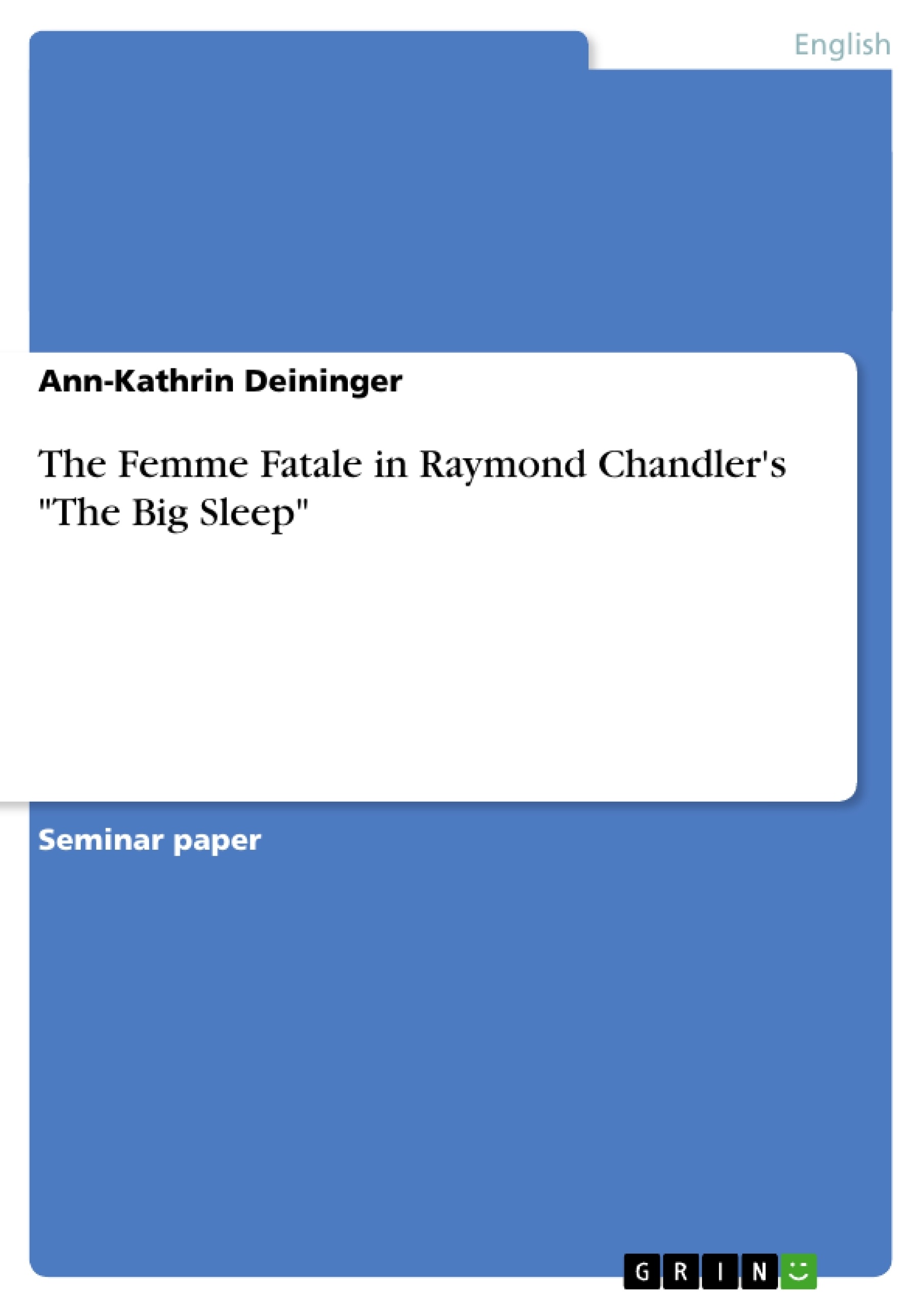According to Janey Place, “the dark lady, the spider woman, the evil seductress who tempts man and brings about his destruction is among the oldest themes of art, literature, mythology and religion in western culture.” She appears in many different forms and many different situations. In the following, I will have a look at the origins of the femme fatale as she is depicted in The Big Sleep. In the first part of the essay I will concentrate on the main female characters and try to find out who appears as a femme fatale. In the second part I will work out that in forming the character of his femme fatale Raymond Chandler borrowed from a common narrative motif, especially from antique Greek and biblical sources. I will have a look at certain antique stories which I cannot retell here, such as the Greek Medea tale, Homer’s Odyssey, the story of Medusa and the biblical Adam and Eve and Joseph stories. In the third part of this essay I will have a look at how the femme fatale is set into the city of film noir and how the city again is similar to mythology.
Inhaltsverzeichnis (Table of Contents)
- I Introduction
- II The Femme Fatale in The Big Sleep
- II. 1 Vivian
- II.2 Carmen
- III Carmen and her Ancestors
- IV The Femme Fatale in the City
Zielsetzung und Themenschwerpunkte (Objectives and Key Themes)
This essay explores the origins and portrayal of the femme fatale in Raymond Chandler's novel The Big Sleep. It examines the characteristics of two key female characters, Vivian and Carmen, and analyzes how they embody the trope of the femme fatale. The essay also delves into the connections between these characters and their ancient mythological counterparts, specifically focusing on the Greek figures of Circe and Medea.
- The origins and evolution of the femme fatale archetype
- The portrayal of female characters in film noir
- The influence of ancient mythology on the characterization of the femme fatale
- The role of ambiguity and deception in the portrayal of female characters
- The relationship between the femme fatale and the urban landscape
Zusammenfassung der Kapitel (Chapter Summaries)
- Introduction: This section introduces the essay's focus on the femme fatale archetype and outlines the key themes and objectives. It establishes the femme fatale as a prominent figure in Western culture, appearing in various forms across art, literature, mythology, and religion.
- The Femme Fatale in The Big Sleep: This chapter analyzes the femme fatale archetype as it is presented in Raymond Chandler's The Big Sleep. It identifies two key female characters, Vivian and Carmen, and examines their characteristics and actions in light of the femme fatale trope. It highlights the novel's departure from the typical portrayal of the femme fatale in film noir, particularly in the film adaptation.
- Vivian: This section focuses on Vivian, one of the Sternwood sisters. While she exhibits some traits of a femme fatale, such as her beauty and use of sexuality, she ultimately lacks the self-serving ambition that defines the archetype. Her motivations are revealed to be driven by a desire to protect her father and sister.
- Carmen: This section delves into the character of Carmen, the other Sternwood sister. She is presented as a more complex and ambiguous character, exhibiting both innocent and dangerous aspects. The essay discusses the use of symbolism and imagery to highlight her duality, linking her to the archetype of the femme fatale. She is characterized by her manipulative nature, her cold-bloodedness, and her ability to exploit others, all of which are common features of the femme fatale.
- Carmen and her Ancestors: This chapter explores the connections between Carmen and ancient mythological figures, particularly the Greek figures of Circe and Medea. The essay analyzes the similarities between these figures, highlighting the recurring themes of manipulation, deception, and ambiguity that define both Carmen and her mythological counterparts.
Schlüsselwörter (Keywords)
This essay focuses on key terms like femme fatale, film noir, mythology, ambiguity, deception, and the urban landscape. It explores the influence of ancient Greek mythology on the characterization of the femme fatale and the role of duality and manipulation in the portrayal of female characters within the context of film noir and literature. It examines the ways in which the city functions as a symbolic setting that mirrors the complex and often dangerous nature of the femme fatale archetype.
- Quote paper
- Ann-Kathrin Deininger (Author), 2004, The Femme Fatale in Raymond Chandler's "The Big Sleep", Munich, GRIN Verlag, https://www.hausarbeiten.de/document/34299


